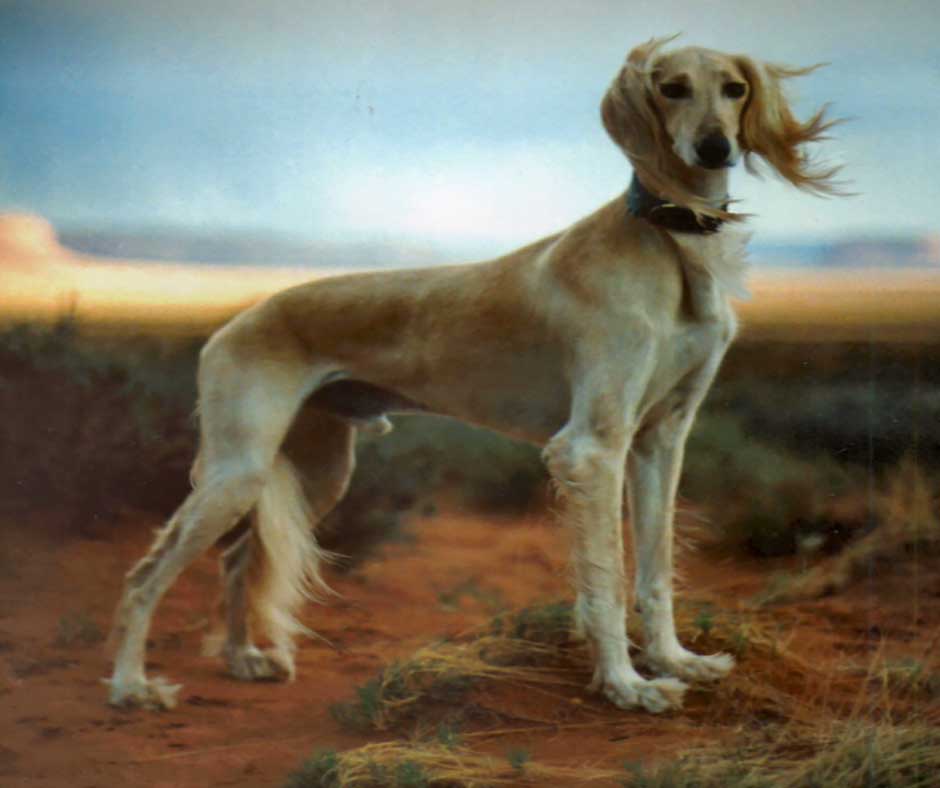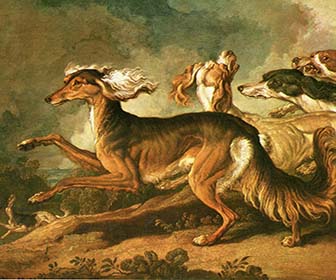595 – Love the Breeds: Salukis with Caroline Coile
Love the Breeds: Salukis with Caroline Coile
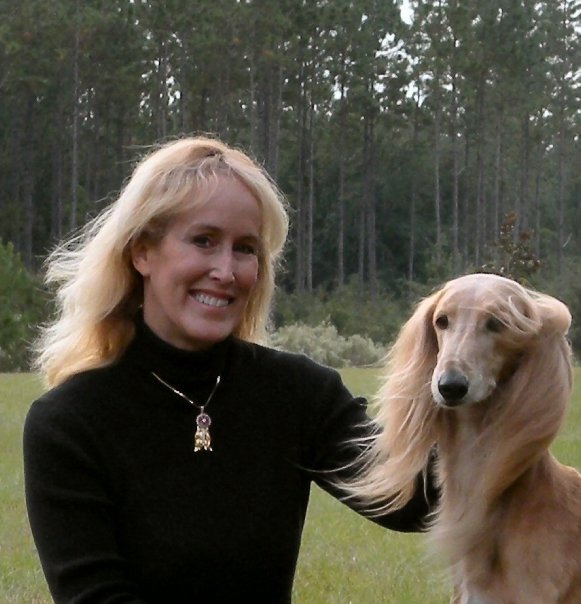
Caroline Coile with her Saluki, Prophet.
Author and Saluki breeder Caroline Coile joins host Laura Reeves for the kick-off of our Love the Breeds feature.
Some of Coile’s tongue-in-cheek descriptions of the ancient breed include “breathing furniture,” “arm candy” and “they don’t like to show their feelings.”
“We have a lot of artwork that does indicate that there were saluki-like dogs … all over the Middle East,” Coile said. “But not just the Middle East, but everywhere the Silk Road went. We see them in China and obviously, it’s pretty easy to take this dog and bring it with you to trade or hunt or whatever.
“We know that some of the first Salukis that came to the western part of the world, to England, were there by the 1700s because there was a famous painting of Zilla … she was, if we can judge from this painting, a gorgeous black and tan, very refined, long feathering… she would have won in the show ring today.
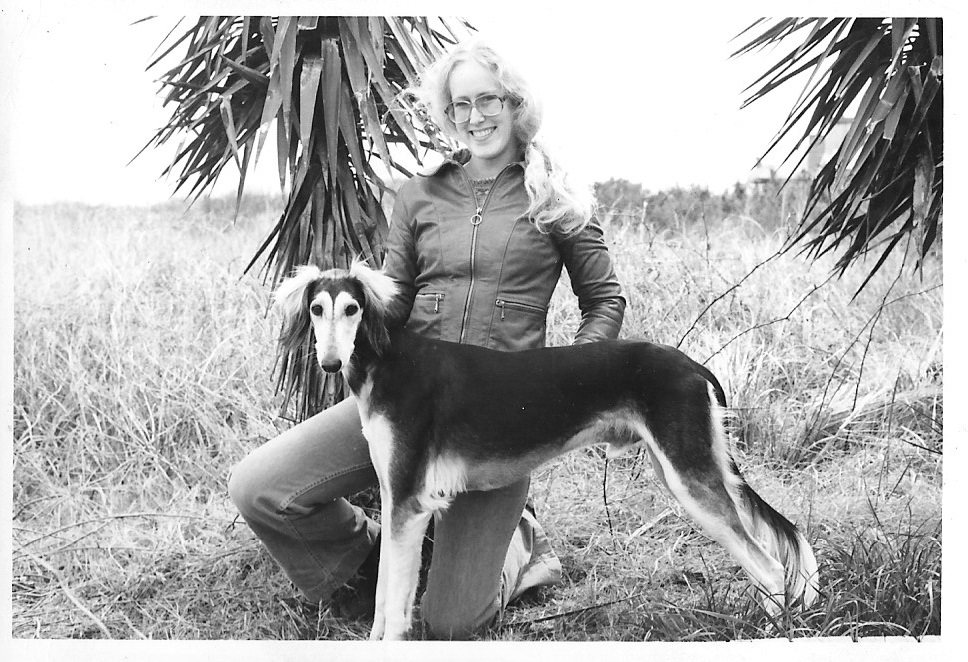
Baha, Ch Srinagar Bhavant Bhairava CD LCM, Coile’s first saluki, in 1975.
“I think that there were two different families (of Salukis), those that went with the Bedouin and they probably hunted hare and rabbit and helped fill their pot with that whatever they could catch. And then I think there were some that the royalty took out on the giant Gazelle Hunts, which would have been a great King Tut and all that sort of thing. A great sport, but probably not a cost efficient one in terms of, you know, calories per what you can bring back.
“An advantage to the Saluki is how peaceful they are. When they’re not going, they’re peaceful and they’re not fighting with each other. They’re not fighters. They get along. This is the norm. They like to sleep in your bed. They won’t stay off your furniture. They are climbers. I have one that can get on the refrigerator. Oh well, she doesn’t just jump up from the floor, she gets on the counter beforehand and won’t stay off that though so I put stuff on the refrigerator to keep it away from her.
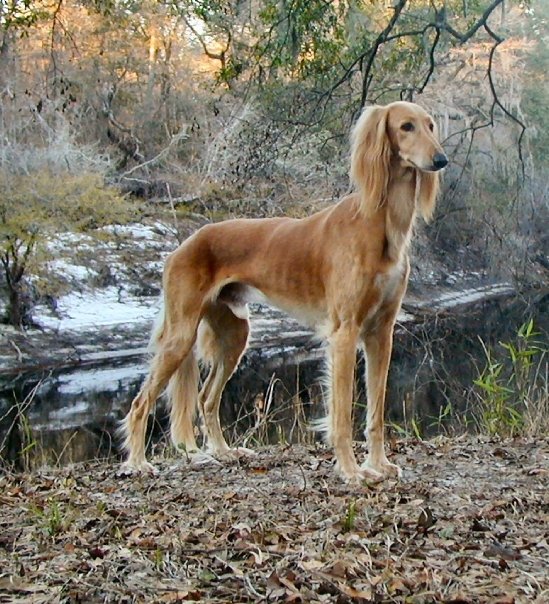
BIS BIF HIT GCh Khiva’s Prophet of Baha, CD, FCh, SC, RA, JOR
“I know one of the things that I think is really important to get across to folks that want to live with what I sort of jokingly, to my friends, refer to as dog arm candy. They’re really beautiful. (But) the important part to remember is they’re dogs and their long developed natural instincts are to chase and kill things and do that very independently.
“The whole motto is that saying ‘if looks could kill’ … you look at their breed standard and that basically defines the saluki breed standard in four words. I get a lot of inquiries from new pet owners saying, ‘We’re marathon runners and we heard that Salukis are long distance runners.’ And I have to say, ‘Yeah, they’re long distance sprinters, if that makes any sense? They can run at full double suspension gallop longer than any other breed, but I guarantee you that if you try to trot with it for any length of time, it’s like dragging an anchor behind you. They’re not into that. They like to go full speed.
“And then the other thing I would say is that I don’t know about other breeds, but Salukis are the biggest complainers of the dog world. Oh, it’s too hot. It’s too cold. Because they act like they’re royalty.”
503 – Examining the History of Sighthounds with Bo Bengtson
Examining the History of Sighthounds with Bo Bengtson
Bo Bengtson, author, publisher and Whippet breeder, attended his first dog show in 1958 in his native Sweden. He joins host Laura Reeves for a deep dive into the intricacies of sighthounds.
“It was, right away, like lightning struck,” Bengtson said. “I was 14 years old and I just knew right away that this was what I wanted to devote my life to. It was really fascinating. It was, as someone once said, a combination of zoo and circus and theater …
A passion for sighthounds
“You have to know a little bit about coursing if you’re involved in sighthounds. They have remained the same for thousands of years, the basic type. They weren’t breeds early on but different types of sighthounds. if you look at the early description of coursing which is the pursuit of game with sighthounds … that is a sport that’s now these days illegal in most of US… It’s been superseded by lure coursing, which is an artificial form of coursing.

“Hunters Homeward Bound,” 10th Century AD. Courtesy of Bo Bengston.
“(Sighthounds developed) before firearms basically, when the only way you had to hunt was through the dogs and whatever they could course and kill was basically today’s dinner. Firearms made sighthounds very much superfluous. And I think the sport then became very much a status symbol. (Sighthounds) are of course aesthetically pleasing and so many rich people and aristocratic people preferred to hunt with sighthounds, not because of need but because it was a beautiful spectacle and pretty expensive spectacle too. In various parts of the world, Queen Elizabeth I was very fond of coursing. In Russia they coursed with Borzoi. And in the Far East there were Salukis.
What IS a Sighthound?
“There is no official definition of what a sighthound is. So there is a great disagreement about what breeds actually count as sighthounds. You can count as few as four or five as pure sighthounds and as many as 40 as “sighthound related” or different types of breeds we don’t know in this country. Some we wouldn’t define as breeds but more as types.
(Listen to fascinating conversations about the Caravan Hounds of India here and here.)
History of sighthound development
“I think we have to go back again a couple of thousand years because there have probably always been different sizes of greyhounds. Greyhound types. The big ones which were the ancestor of the modern greyhound. And we have the different, smaller ones that were ancestors of whippet and the Italian greyhounds. I think that Whippets, although they weren’t described as a breed until late 1800s, they have certainly been around much longer. Catherine the Great of Russia had little English greyhounds she called them. And they were very important to her. She nursed them herself and they slept on a pink couch in her bedroom. But whether they’re Italian greyhounds, whether they were whippet, who knows. I mean they were very small and whether Italian greyhounds or whippets, it is kind of irrelevant these days.
“The Greyhound and the Saluki are sort of the “ur” sighthound, what sighthounds are supposed to be like. … if you take one step away from Saluki you get the Afghan Hound, which is a little more powerful. If you take several steps away from the Greyhound, you get the Ibizan Hound and you get the Portuguese Podengo and that kind of thing.”
Listen to the full episode for more detailed insights into all things sighthound.
248 – LIVE: Laura on Breed Specific Presentation Featuring Sighthounds
Commonalities and Differences in Sighthounds
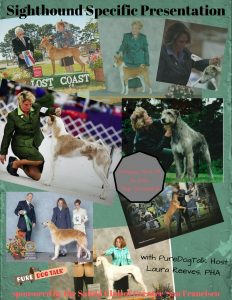
LIVE seminar hosted by the Saluki Club of Greater San Francisco
Live from the Harvest Moon Cluster, your host Laura Reeves talks sighthounds. The seminar was sponsored by the Saluki Club of Greater San Francisco. Watch and listen to the entire seminar here.
Temperament and showmanship are part of breed type. Our job as handlers is to showcase our breed’s character and personality accurately, not make our Wolfhound show like a Doberman. For breeds with less “flash” that might be overlooked in group competition, it is incumbent on us as handlers to provide an engaging, effortless back drop.
Pretty Hands
Our hands tell a story in the show ring. How and where we place our hands on the dog is part of the presentation. Sighthounds specifically call for soft, quiet, elegant hands. Holding the collar, placing the feet, should be done gracefully. Quietly drawing the judge’s eye to our dog’s finest features while using our hands as a “frame,” we actually can “talk with our hands” and subtly communicate with the judge.
Dog handling in general is best done when we are judicious and smooth with our hands. The unique nature of sighthounds means than keeping your hands on the dog at all times will help steady the dog and allow him to be balanced on his own feet.
While showcasing our dogs involves a bit of “sleight of hand” in terms of maintaining emphasis on the good and not the faults, Laura shares her 1-2-3-4-5 hand stacking method as a refresher course. Hear more in depth discussion on this topic in episode 2, “How to Stack Your Dog” or in our new audio book, debuting in January.
Give Your Dog What it Needs: Confidence and Focus
All dogs take their cues from us as the handlers. Sighthounds are particularly in tune with their people and draw their confidence from us. Be sure you are relaxed and enjoying spending time with your dog for your best result.
Moving Gracefully – Float with Your Dog
Drive from the hip and a gradual and collected acceleration are keys to showing the judge your dog’s best movement. Don’t let your dog look like “an octopus on speed” by following these suggestions. More discussion in episode 3 and in the audio book.
Ears and Tails
Each of the sighthounds, and really all dogs, have a correct ear and tail carriage to “make the picture” for the judge. Learn how to work with your dog’s attitude to get the best results.

